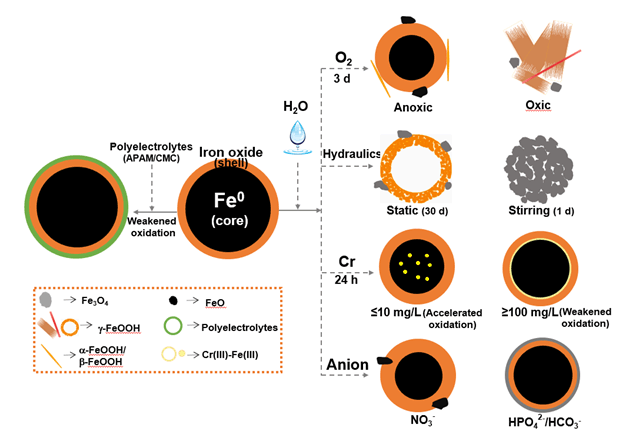| [1] Alowitz, M. J.; Scherer, M. M. Environ. Sci. Technol. 2002, 36, 299.
[2] Johnson, T. L.; Scherer, M. M.; Tratnyek, P. G. Environ. Sci. Technol. 1996, 30, 2634.
[3] Matheson, L. J.; Tratnyek, P. G. Environ. Sci. Technol. 1994, 28, 2045.
[4] Bang, S.; Korfiatis, G. P.; Meng, X. J. Hazard. Mater. 2005, 121, 61.
[5] Wang, C. B.; Zhang, W. X. Environ. Sci. Technol. 1997, 31, 2154.
[6] Shu, H. Y.; Chang, M. C.; Chen, C. C.; Chen, P. E. J. Hazard. Mater. 2010, 184, 499.
[7] Sohn, K.; Kang, S. W.; Ahn, S.; Woo, M.; Yang, S. K. Environ. Sci. Technol. 2006, 40, 5514.
[8] Huang, X. Y.; Wang, W.; Ling, L.; Zhang, W. X. Acta Chim. Sinica 2017, 75, 529(in Chinese). (黄潇月, 王伟, 凌岚, 张伟贤, 化学学报, 2017, 75, 529.)
[9] Gu, T.; Shi, J.; Hua, Y.; Liu, J.; Wang, W.; Zhang, W. X. Acta Chim. Sinica 2017, 75, 991(in Chinese). (顾天航, 石君明, 滑熠龙, 刘静, 王伟, 张伟贤, 化学学报, 2017, 75, 991.)
[10] Xia, X.; Hua, Y.; Huang, X.; Ling, L.; Zhang, W. X. Acta Chim. Sinica 2017, 75, 594(in Chinese). (夏雪芬, 滑熠龙, 黄潇月, 凌岚, 张伟贤, 化学学报, 2017, 75, 594.)
[11] Liu, A.; Liu, J.; Han, J.; Zhang, W. X. J. Hazard. Mater. 2017, 322, 129.
[12] Liu, A. R.; Liu, J.; Zhang, W. X. Chemosphere 2015, 119, 1068.
[13] Liu, A. R.; Liu, J.; Pan, B. C.; Zhang, W. X. RSC Adv. 2014, 4, 57377.
[14] Mu, Y.; Jia, F.; Ai, Z.; Zhang, L. Acta Chim. Sinica 2017, 75, 538 (in Chinese). (穆毅, 贾法龙, 艾智慧, 张礼知, 化学学报, 2017, 75, 538.)
[15] Wang, C. Y.; Chen, Z. Y.; Cheng, B.; Zhu, Y. R.; Liu, H. J. Mater. Sci. Eng. B 1999, 60, 223.
[16] Liu, A. R.; Zhang, W. X. Analyst 2014, 139, 4512.
[17] Wang, C.; Baer, D. R.; Amonette, J. E.; Engelhard, M. H.; Antony, J.; Qiang, Y. J. Am. Chem. Soc. 2009, 131, 8824.
[18] Nurmi, J. T.; Tratnyek, P. G.; Sarathy, V.; Baer, D. R.; Amonette, J. E.; Pecher, K.; Wang, C.; Linehan, J. C.; Matson, D. W.; Penn, R. L. Environ. Sci. Technol. 2005, 39, 1221.
[19] Yan, W.; Herzing, A. A.; Kiely, C. J.; Zhang, W. X. J. Contam. Hydrol. 2010, 118, 96.
[20] Liu, Y.; Majetich, S. A.; Tilton, R. D.; Sholl, D. S.; Lowry, G. V. Environ. Sci. Technol. 2005, 39, 1338.
[21] Kim, H. S.; Kim, T.; Ahn, J. Y.; Hwang, K. Y.; Park, J. Y.; Lim, T. T.; Hwang, I. Chem. Eng. J. 2012, 197, 16.
[22] Kanel, S. R.; Greneche, J. M.; Choi, H. Environ. Sci. Technol. 2006, 40, 2045.
[23] Ling, L.; Zhang, W. X. Environ. Sci. Technol. Lett. 2014, 1, 209.
[24] Yan, W. L.; Herzing, A. A.; Li, X. Q.; Kiely, C. J.; Zhang, W. X. Environ. Sci. Technol. 2010, 44, 4288.
[25] Ling, L.; Zhang, W. X. RSC Adv. 2014, 4, 33861.
[26] Ling, L.; Huang, X. Y.; Zhang, W. X. Adv. Mater. 2018, 1705703.
[27] Ling, L.; Zhang, W. X. Environ. Sci. Technol. Lett. 2014, 1, 305.
[28] Kanel, S. R.; Manning, B.; Charlet, L.; Choi, H. Environ. Sci. Technol. 2005, 39, 1291.
[29] Feng, H.; Tang, L.; Tang, J.; Zeng, G.; Dong, H.; Deng, Y.; Wang, L.; Liu, Y.; Ren, X.; Zhou, Y. Environ. Sci. Nano 2018, 5, 1595.
[30] Tang, L.; Feng, H.; Tang, J.; Zeng, G.; Deng, Y.; Wang, J.; Liu, Y.; Zhou, Y. Water Res. 2017, 117, 175.
[31] Ling, L.; Pan, B. C.; Zhang, W. X. Water Res. 2015, 71, 274.
[32] Ling, L.; Zhang, W. X. J. Am. Chem. Soc. 2015, 137, 2788.
[33] Huang, X. Y.; Ling, L.; Zhang, W. X. J. Environ. Sci. 2018, 67, 4.
[34] Xia, X. F.; Ling, L.; Zhang, W. X.. Environ. Sci. Nano 2017, 4, 52.
[35] Xia, X. F.; Ling, L.; Zhang, W. X. Chemosphere 2017, 168, 1597.
[36] Liu, H. B.; Chen, T. H.; Chang, D. Y.; Chen, D.; Liu, Y.; He, H. P.; Yuan, P.; Frost, R. Mater. Chem. Phys. 2012, 133, 205.
[37] Liu, Y.; Phenrat, T.; Lowry, G. V. Environ. Sci. Technol. 2007, 41, 7881.
[38] Reinsch, B. C.; Forsberg, B.; Penn, R. L.; Kim, C. S.; Lowry, G. V. Environ. Sci. Technol. 2010, 44, 3455.
[39] Almeelbi, T.; Bezbaruah, A. J. Nanopart. Res. 2012, 14, 900.
[40] Wen, Z.; Zhang, Y.; Dai, C. Colloid. Surface A 2014, 457, 433.
[41] Hua, Y.; Wang, W.; Huang, X.; Gu, T.; Ding, D.; Ling, L.; Zhang, W. X. Chemosphere 2018, 201, 603.
[42] Jiemvarangkul, P.; Zhang, W. X.; Lien, H. L. Chem. Eng. J. 2011, 170, 482.
[43] Johnson, R. L.; Nurmi, J. T.; O'Brien Johnson, G. S.; Fan, D.; O'Brien Johnson, R. L.; Shi, Z.; Salter-Blanc, A. J.; Tratnyek, P. G.; Lowry, G. V. Environ. Sci. Technol. 2013, 47, 1573.
[44] Liu, J.; Liu, A. R.; Zhang, W. X. Chem. Eng. J. 2016, 303, 26832.
[45] Tang, J.; Tang, L.; Feng, H.; Dong, H.; Zhang, Y.; Liu, S.; Zeng, G. Acta Chim. Sinica 2017, 75, 575(in Chinese). (汤晶, 汤琳, 冯浩朋, 董浩然, 章毅, 刘思诗, 曾光明, 化学学报, 2017, 75, 575.)
[46] Su, Y. M.; Adeleye, A. S.; Keller, A. A.; Huang, Y. X.; Dai, C. M.; Zhou, X. F.; Zhang, Y. L. Water Res. 2015, 74, 47.
[47] Rajajayavel, S. R. C.; Ghoshal, S. Water Res. 2015, 78, 144. |
